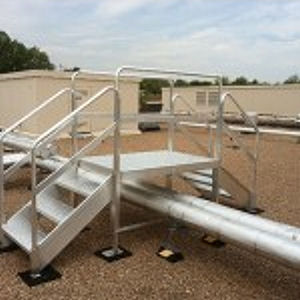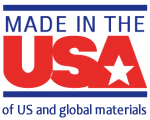Crossover stairs are essential for workplaces where employees and visitors need a safe way to go over pipes, assembly lines, electronic devices, and other moving materials or hazards. The REDD Team can help you design and build a new American-made aluminum crossover stairs setup that you can install at your property. We use the best-quality materials when building our stairs, plus our aluminum materials are about a third the weight of steel items, so it’s easier to install these steps.
 You’ll need to ensure the design for your crossover stairs is managed well. You will require a suitable layout that provides enough room for people to safely go over a spot while keeping from obstructing whatever goes underneath the surface.
You’ll need to ensure the design for your crossover stairs is managed well. You will require a suitable layout that provides enough room for people to safely go over a spot while keeping from obstructing whatever goes underneath the surface.
How Is the Stairwell Shaped?
Your crossover stairs will feature a trapezoid-like design in most situations. The stairs will feature steps that go up, a landing that goes over the hazard you’re trying to traverse, and another set of steps that go down.
The steps can be as long or high as necessary. The goal is to create enough clearance between the item in question and the stairs.
What Is the Ideal Clearance?
The clearance for your crossover stairs should include enough room between the steps and whatever item you’re going over. Be sure to look at the design of your item and anything that might appear on it. If you’re going over a pipe or a machine, be sure there’s enough room so vibrations won’t impact the steps.
For cases where your stairs will go over a conveyor, the stairs should be high enough so that anything on the belt won’t bump into the steps and cause disruptions.
How Will You Design the Steps?
The steps should be wide and long enough to where people can go up and down them. The steps should be at least 24 inches wide, and they should also be 12 inches deep. The risers between steps should be about 6 to 8 inches per step, so consider this when looking at how many steps will appear on each side.
All steps must also have suitable treads to ensure each person has a good enough surface that keeps people from slipping. Proper guardrails are also necessary for protecting the user and ensuring the user won’t lose one’s balance when going up or down.
Depending on how high the steps go, you might also need extended landings in the middle. These landings can work for longer staircases as rest spots or when the steps need to change direction.
Crossover stairs are essential for protecting your workers and helping them go over many obstacles in the workplace. But make sure when designing them that you have a plan for how they will work and that they won’t obstruct anything underneath them. You can contact us at REDD Team if you require further help getting your steps ready. You can call us at (800) 648-3696 for further details or visit our website to see our full array of aluminum access products that can work for your property.

